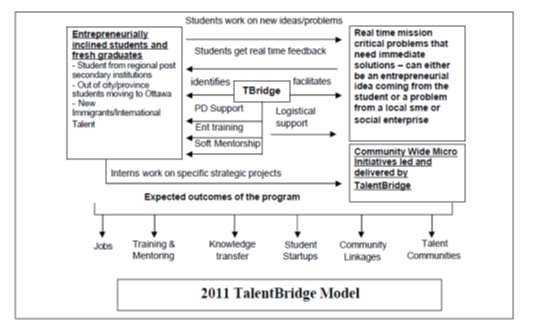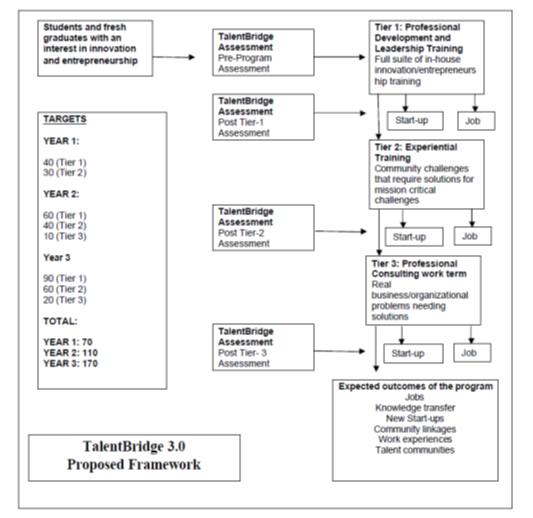From 2008 to 2012, I had the privilege of leading the TalentBridge program at OCRI, dedicated to developing practical innovators – young individuals from Ottawa ready to think creatively, adapt swiftly, and drive meaningful change. Our foundation at TalentBridge was built on a few key principles designed to encourage participants to explore their potential, hone their skills, and transform ideas into tangible impact. These pillars defined our approach and became the essence of what TalentBridge was all about.
1. Creativity as a Core Competency
Creativity was at the heart of everything we did. To us, it wasn’t just about brainstorming new ideas; it was about cultivating a mindset willing to question, explore, and challenge assumptions. Being curious, staying open-minded, and having the courage to see the world differently were qualities we aimed to instill in everyone who came through TalentBridge. This wasn’t creativity for creativity’s sake – it was creativity with the purpose of bringing real, practical value to the table.
Our approach emphasized that true creativity combines exploration with humility. By embracing curiosity as a core skill, we encouraged participants to see creativity not as an occasional spark but as a discipline – one that could grow and evolve.
2. The Innovator’s DNA: Developing Discovery Skills
Turning creativity into something actionable required more than just an idea; it required a way of thinking. TalentBridge incorporated a framework inspired by the Innovator’s DNA to develop five core discovery skills that became our guiding principles for practical innovation:
- Observation: We encouraged participants to look beyond the obvious, pay attention to what others might miss, and uncover hidden opportunities by noticing patterns.
- Questioning: Curiosity drove our process. We fostered a habit of questioning – asking “why” and “how” – to dig deeper, reveal new perspectives, and challenge assumptions.
- Networking: TalentBridge taught that networking wasn’t just about connections but about accessing fresh ideas, perspectives, and insights that expanded understanding and sparked innovation.
- Experimentation: We built a culture of iteration, where testing ideas, learning from each trial, and adapting based on feedback was essential. This mindset nurtured resilience and adaptability in participants.
- Associating: One of our most valued skills was the ability to connect seemingly unrelated concepts. Associating enabled participants to bridge ideas in fresh, actionable ways.
These discovery skills were more than a checklist; they represented a mindset that helped participants recognize opportunities, act on ideas, and tackle challenges creatively.
3. From Ideas to Execution
TalentBridge was committed to a culture that valued action. Ideas alone don’t drive change; execution does. We didn’t just encourage participants to generate ideas – we taught them to see those ideas as adaptable, evolving entities that needed testing, refining, and focused follow-through to truly have an impact.
The program taught participants to think of ideas as living hypotheses, structured with feedback loops and designed to be adapted. A great idea, we believed, should never be monolithic. Instead, it should be built for testing, revision, and growth. This emphasis on execution with purpose helped participants understand that success came not from a single flash of insight but from continuous, thoughtful action.
4. Learning Through Failure
One of the core principles of TalentBridge was reframing failure as an integral part of growth. We taught participants that failure wasn’t just about mistakes; it was about recognizing what went wrong, learning from it, and adjusting the approach. We often discussed “error recognition and recovery” as part of a resilient mindset – where failure wasn’t a setback but a step forward.
At the same time, we fostered a healthy respect for discernment, emphasizing that not all failures were recoverable. We encouraged participants to see failure as valuable only when it led to iteration: recalibrating assumptions, modifying methods, and pressing forward with renewed clarity.
5. The Power of Curation
As the world became increasingly saturated with information, the ability to curate – extracting knowledge from a sea of data and applying it purposefully – became essential. TalentBridge helped participants develop the skill of curation, emphasizing informed decision-making. The program taught that true curation was about discerning valuable insights and applying them in ways that could unlock new opportunities.
Our approach encouraged participants to go beyond gathering information, using critical thinking and a selective eye to create meaningful applications. This skill would only grow in importance as data became more abundant and complex.
Conclusion: Building an Adaptive Mindset
TalentBridge was more than a program – it was a journey to nurture innovative, adaptable thinkers ready to embrace the future’s uncertainties. These core pillars – creativity, discovery skills, execution, learning from failure, and curation – formed the foundation for participants to grow not only as professionals but as resilient, thoughtful contributors to their communities.
These values continue to guide my approach today. Through TalentBridge, I learned that innovation isn’t simply about having ideas. It’s about building a mindset that’s curious, resilient, and always ready to learn. These principles of curiosity, adaptability, and the courage to pursue meaningful impact remain close to me, as relevant today as they were then.

